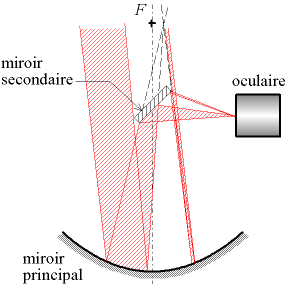Catoptrics
Catoptrics is the branch of optics that deals with the properties and phenomena of reflection and the formation of images by reflecting surfaces, such as mirrors. This field of study is fundamental in understanding how light interacts with surfaces that do not transmit light but instead cause it to bounce back. Catoptrics is one of the oldest sub-disciplines within optics, with its principles being explored as far back as ancient Greece.
History[edit | edit source]
The study of catoptrics can be traced back to ancient civilizations, where the principles of light reflection were applied in creating tools and devices. The most notable early work on catoptrics is attributed to the mathematician Euclid, who described the laws of reflection in his work "Catoptrics." Later, the contributions of Archimedes in designing reflective devices for military purposes showcased the practical applications of catoptrics. In the Renaissance, scientists like Leonardo da Vinci and Johannes Kepler further advanced the understanding of light and reflection, laying the groundwork for modern optical science.
Principles of Catoptrics[edit | edit source]
The fundamental principle of catoptrics is the law of reflection, which states that the angle of incidence (the angle at which light hits a surface) is equal to the angle of reflection (the angle at which light bounces off the surface). This principle applies to smooth, reflective surfaces where light rays are reflected in a predictable manner. Catoptrics also explores the formation of images by mirrors, including plane mirrors, concave mirrors, and convex mirrors, each of which forms images in unique ways due to the curvature of the reflecting surface.
Plane Mirrors[edit | edit source]
In plane mirrors, images are formed with characteristics such as being the same size as the object, upright, and laterally inverted. Plane mirrors are often used in everyday applications like bathroom mirrors because they provide a straightforward reflection without distorting the image.
Concave and Convex Mirrors[edit | edit source]
Concave mirrors can produce real or virtual images depending on the position of the object relative to the focal point of the mirror. These mirrors are used in devices that require image magnification, such as telescopes and shaving mirrors. On the other hand, convex mirrors always produce virtual, diminished, and upright images, making them ideal for security and rear-view mirrors in vehicles.
Applications of Catoptrics[edit | edit source]
The principles of catoptrics have a wide range of applications in various fields. In astronomy, telescopes use mirrors to collect and focus light from distant celestial objects. In architecture and interior design, mirrors are strategically placed to enhance natural light or create an illusion of space. Catoptrics is also crucial in the development of optical instruments and technologies, including lasers, periscopes, and optical fiber systems.
See Also[edit | edit source]
Search WikiMD
Ad.Tired of being Overweight? Try W8MD's physician weight loss program.
Semaglutide (Ozempic / Wegovy and Tirzepatide (Mounjaro / Zepbound) available.
Advertise on WikiMD
|
WikiMD's Wellness Encyclopedia |
| Let Food Be Thy Medicine Medicine Thy Food - Hippocrates |
Translate this page: - East Asian
中文,
日本,
한국어,
South Asian
हिन्दी,
தமிழ்,
తెలుగు,
Urdu,
ಕನ್ನಡ,
Southeast Asian
Indonesian,
Vietnamese,
Thai,
မြန်မာဘာသာ,
বাংলা
European
español,
Deutsch,
français,
Greek,
português do Brasil,
polski,
română,
русский,
Nederlands,
norsk,
svenska,
suomi,
Italian
Middle Eastern & African
عربى,
Turkish,
Persian,
Hebrew,
Afrikaans,
isiZulu,
Kiswahili,
Other
Bulgarian,
Hungarian,
Czech,
Swedish,
മലയാളം,
मराठी,
ਪੰਜਾਬੀ,
ગુજરાતી,
Portuguese,
Ukrainian
Medical Disclaimer: WikiMD is not a substitute for professional medical advice. The information on WikiMD is provided as an information resource only, may be incorrect, outdated or misleading, and is not to be used or relied on for any diagnostic or treatment purposes. Please consult your health care provider before making any healthcare decisions or for guidance about a specific medical condition. WikiMD expressly disclaims responsibility, and shall have no liability, for any damages, loss, injury, or liability whatsoever suffered as a result of your reliance on the information contained in this site. By visiting this site you agree to the foregoing terms and conditions, which may from time to time be changed or supplemented by WikiMD. If you do not agree to the foregoing terms and conditions, you should not enter or use this site. See full disclaimer.
Credits:Most images are courtesy of Wikimedia commons, and templates, categories Wikipedia, licensed under CC BY SA or similar.
Contributors: Prab R. Tumpati, MD

